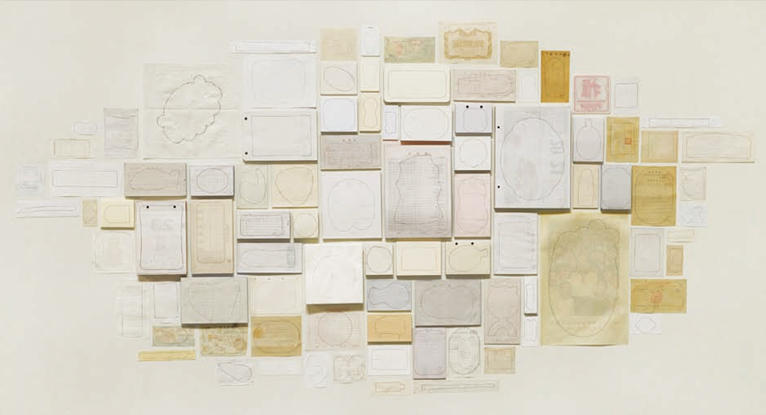HONG HAO: AS IT IS
| April 9, 2012 | Post In LEAP 13

Using things from the past, both material (old documents or objects) and immaterial (memories or forms), has already become stale artistic practice; many artists nowadays instead exert great effort searching for the differences, or the dialectical relationship, between the past and the present. Although Hong Hao makes use of “old” materials in this exhibition, it has nothing to do with either of the two aforementioned trends.
It is clear from this solo exhibition that Hong Hao’s practice has entered a new phase of development. His longstanding sarcastic and comical spirit remains, though now focused on the philosophical examination of materiality itself, or towards the greater abstract logic concealed within his works. He pays more attention to the object as the embodiment of meaning in graphic or substantive terms. By adopting a decidedly graphic and abstract approach, he has produced a new collection of nearly impenetrable work. For part of this exhibition, the artist procured numerous old objects— mirrors, soap boxes, and so on— then laid these out on an adequately sized sheets of old paper and traced around their form with the most everyday of pencils and ballpoint pens. A philosophical interpretation can naturally be drawn, if need be, although the audience may be better off imagining Hong playfully sitting down with all these objects and pondering which to inscribe onto what paper. This object with that sheet of paper, or with the written contents of this paper: such is the absolute logical disparity between the two that the only connection that can be forged is in the bare form of each, in the latter’s ability to contain the former. This abstract, material-reliant logic may simply make the audience chuckle, though Hong’s intention is to point out that such a logic definitely exists: a logic found between material and form. In this instance, Hong has applied his well-honed ability to tease and ridicule the physical world to a much purer, formal investigation. And this investigation is not about “immateriality” or “anti-materiality,” but rather about “self-materiality” and “inter-materiality.” Such a rumination on material and form verges on mockery.
Everyday objects remain his materials of choice, such as the maps that feature innumerably throughout his past work. Now there are not only maps, but receipts, old documents, and large quantities of personal letters and other handwritten materials both private and official. In another set of works featured in this exhibition, Hong Hao imitates the punishment of a schoolchild, earnestly filling in characters, one by one. The characters are clearly visible, though written on the wrong side of the graph paper, thus appearing backwards on presentation. What can be seen from the back? The characters are written vigorously, the ink deeply infiltrating the paper. In the context of the classroom, this signifies both determination and willpower. But Hong Hao’s writing, shown in reverse, not only robs the characters of their original meaning, turning them into pure geometric forms, but also ridicules the value system that upholds the writing. Similarly, in literature, writing backwards signifies writing in the wrong direction. In other words, it means opposition, and the preposition “anti” immediately signifies an oppositional stance. In fact, not one of the numerous sheets of paper displayed in this exhibition appears right side up, forcing the audience to read each document backwards. Why would Hong want us to see them in this way? Flip a world map the wrong way around and the viewer suddenly stands behind the world; east and west are subjected to metaphorical displacement, and although all nations’ borders remain, they are reversed in comical subversion.
In this exhibition, Hong Hao reveals his consideration of objects using a simple and concise methodology. Full of lighthearted philosophical intrigue, its physical articulation appears calm and intelligent. Even the exhibition’s title seems to take the form of a tactful joke, as nothing is obviously not “as it is.” Liu Xi (Translated by Dominik Salter Dvorak)

